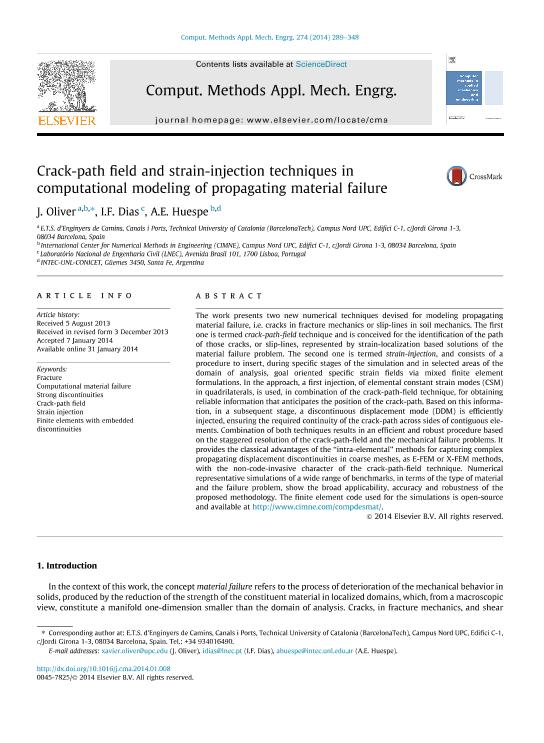Mostrar el registro sencillo del ítem
dc.contributor.author
Oliver, J.
dc.contributor.author
Dias, I. F.
dc.contributor.author
Huespe, Alfredo Edmundo

dc.date.available
2017-07-05T20:20:49Z
dc.date.issued
2014-01
dc.identifier.citation
Oliver, J.; Dias, I. F.; Huespe, Alfredo Edmundo; Crack-path field and strain-injection techniques in computational modeling of propagating material failure; Elsevier; Computer Methods In Applied Mechanics And Engineering; 274; 1-2014; 289-348
dc.identifier.issn
0045-7825
dc.identifier.uri
http://hdl.handle.net/11336/19682
dc.description.abstract
The work presents two new numerical techniques devised for modeling propagating material failure, i.e. cracks in fracture mechanics or slip-lines in soil mechanics. The first one is termed crack-path-field technique and is conceived for the identification of the path of those cracks, or slip-lines, represented by strain-localization based solutions of the material failure problem. The second one is termed strain-injection, and consists of a procedure to insert, during specific stages of the simulation and in selected areas of the domain of analysis, goal oriented specific strain fields via mixed finite element formulations. In the approach, a first injection, of elemental constant strain modes (CSM) in quadrilaterals, is used, in combination of the crack-path-field technique, for obtaining reliable information that anticipates the position of the crack-path. Based on this information, in a subsequent stage, a discontinuous displacement mode (DDM) is efficiently injected, ensuring the required continuity of the crack-path across sides of contiguous elements. Combination of both techniques results in an efficient and robust procedure based on the staggered resolution of the crack-path-field and the mechanical failure problems. It provides the classical advantages of the “intra-elemental” methods for capturing complex propagating displacement discontinuities in coarse meshes, as E-FEM or X-FEM methods, with the non-code-invasive character of the crack-path-field technique. Numerical representative simulations of a wide range of benchmarks, in terms of the type of material and the failure problem, show the broad applicability, accuracy and robustness of the proposed methodology. The finite element code used for the simulations is open-source and available at http://www.cimne.com/compdesmat/.
dc.format
application/pdf
dc.language.iso
eng
dc.publisher
Elsevier

dc.rights
info:eu-repo/semantics/openAccess
dc.rights.uri
https://creativecommons.org/licenses/by-nc-sa/2.5/ar/
dc.subject
Computational Material Failure
dc.subject
Crack-Path Field
dc.subject
Finite Elements with Embedded Discontinuities
dc.subject
Mixed Formulations
dc.subject
Fracture
dc.subject
Strong Discontinuities
dc.subject.classification
Mecánica Aplicada

dc.subject.classification
Ingeniería Mecánica

dc.subject.classification
INGENIERÍAS Y TECNOLOGÍAS

dc.title
Crack-path field and strain-injection techniques in computational modeling of propagating material failure
dc.type
info:eu-repo/semantics/article
dc.type
info:ar-repo/semantics/artículo
dc.type
info:eu-repo/semantics/publishedVersion
dc.date.updated
2017-07-03T19:51:35Z
dc.journal.volume
274
dc.journal.pagination
289-348
dc.journal.pais
Países Bajos

dc.journal.ciudad
Amsterdam
dc.description.fil
Fil: Oliver, J.. Universidad Politecnica de Catalunya; España
dc.description.fil
Fil: Dias, I. F.. Laboratório Nacional de Engenharia Civil; Portugal
dc.description.fil
Fil: Huespe, Alfredo Edmundo. Consejo Nacional de Investigaciones Científicas y Técnicas. Centro Científico Tecnológico Conicet - Santa Fe. Instituto de Desarrollo Tecnológico para la Industria Química. Universidad Nacional del Litoral. Instituto de Desarrollo Tecnológico para la Industria Química; Argentina. Universidad Politecnica de Catalunya; España
dc.journal.title
Computer Methods In Applied Mechanics And Engineering

dc.relation.alternativeid
info:eu-repo/semantics/altIdentifier/doi/http://dx.doi.org/10.1016/j.cma.2014.01.008
dc.relation.alternativeid
info:eu-repo/semantics/altIdentifier/url/http://www.sciencedirect.com/science/article/pii/S0045782514000139?via%3Dihub
Archivos asociados
